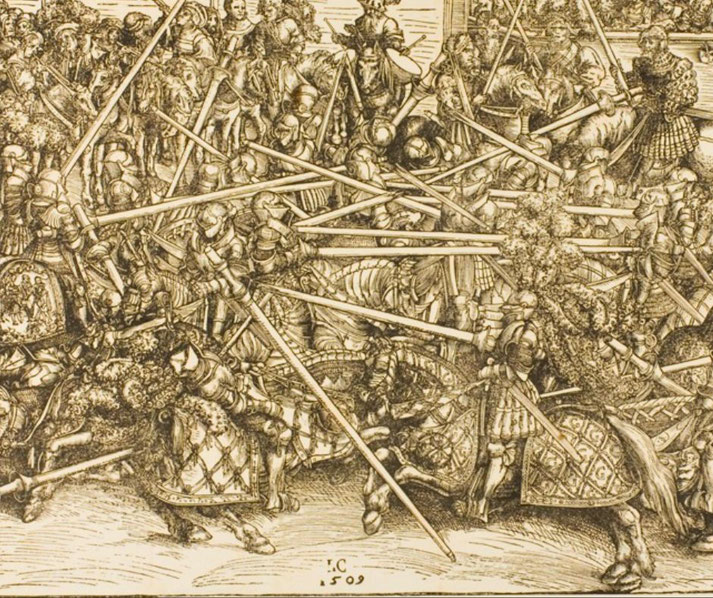The Wars of the Roses: How a royal family feud tore England apart

In the middle of the 15th century in the heart of medieval England, a storm was brewing: one that would see the land soaked in blood and divided by loyalty.
This was not a simple war of conquest or rebellion; it was a family feud on an epic scale, pitting cousin against cousin, brother against brother.
The origins of the war
The seeds of this conflict were sown almost 100 years earlier, during the reign of King Edward III, from 1327-1377.
He had so many children that his family was full of people who claimed to be the next in line to the throne of England.
When Edward III died, his grandson, Richard II became king, even though he was 10 years old.
Since he was a child, a group of men, led by his uncle, John of Gaunt, took charge of the kingdom.
When Richard II was old enough and John of Gaunt had died, he punished these men in 1399 for taking control away from him.
He even took away the land of John of Gaunt’s son, Henry Bolingbroke.
This outraged Henry Bolingbroke, who then invaded England and deposed Richard II. Richard would die in captivity.
This set a precedent that the throne could be seized by force, leading to rivalry and tension between the descendants of Edward III's sons.
What were the Houses of Lancaster and York?
The Wars of the Roses saw two primary factions vying for control, known as the Houses of Lancaster and York.
Both the Houses of Lancaster and York trace their lineage back to King Edward III of England, making the Wars of the Roses essentially a family feud.
The Lancastrian line began with John of Gaunt, the third surviving son of Edward III.
John was the Duke of Lancaster, and his descendants, including his son Henry Bolingbroke, became known as the Lancastrians.
Henry Bolingbroke later became King Henry IV after deposing Richard II, establishing the Lancastrian claim to the throne.
The Yorkist line originated from two of Edward III's sons: Edmund of Langley, the first Duke of York (the fourth surviving son), and Lionel of Antwerp, Duke of Clarence (the second surviving son).
Richard, Duke of York, who initially pressed the Yorkist claim to the throne during the Wars of the Roses, was a descendant of both Edmund and Lionel, which he believed gave him a superior claim to the throne over the Lancastrians.
What were the differences between the two Houses?
The primary difference between the two houses was their respective claims to the English throne.
The Lancastrians, through Henry IV, had possession of the crown, but the Yorkists believed their claim was more direct and legitimate due to their descent from both the second and fourth sons of Edward III, as opposed to the Lancastrians' descent from the third son.
Each house was represented by a rose: the red rose for Lancaster and the white rose for York.
These symbols became deeply associated with each faction and are still recognized today as emblems of this conflict.
Over time, each house garnered support from various nobles and regions. The Lancastrians had strong backing in the northern parts of England, while the Yorkists found significant support in the southern and eastern regions.

The main power-players of the war
At the heart of the conflict was the weak rule of King Henry VI, a Lancastrian monarch.
His bouts of mental illness and inability to provide strong leadership created a power vacuum, which ambitious nobles sought to fill.
His queen, Margaret of Anjou, became a formidable Lancastrian leader in her own right, defending her husband's claim to the throne and her son's future prospects.
The political instability of Henry's reign provided an opening for the House of York, led initially by Richard, Duke of York, to challenge the Lancastrian hold on the throne.
The key events of the Wars of the Roses
The First Battle of St Albans (May 22, 1455):
The first clash came at St Albans in 1455. The streets echoed with the clash of steel and the cries of fallen men. The Yorkists emerged victorious, capturing the mentally unstable King Henry VI.
The Battle of Wakefield (December 30, 1460):
Tragedy struck the Yorkists at Wakefield when Richard was killed. But from the ashes rose a new leader, his son Edward. He was a young, charismatic, and determined leader, and the death of his father only fueled his ambitions.
The Battle of Towton (March 29, 1461):
Edward led the Yorkists to a resounding victory at Towton, one of the bloodiest battles ever fought on English soil. The outcome saw the charismatic Edward ascend the throne as Edward IV.
The Readeption of Henry VI (October 1470 - April 1471):
However, the path to the throne was fraught with treachery and shifting allegiances. One of the most influential figures of the time was Richard Neville, the Earl of Warwick, aptly nicknamed the "Kingmaker." Initially a staunch Yorkist supporter, Warwick's ambitions led him to switch sides, restoring Henry VI to the throne.

Battle of Tewkesbury (May 4, 1471)
Yet, this restoration was short-lived. The Lancastrians faced a crushing defeat at the Battle of Tewkesbury in 1471, where the prince heir to the Lancastrian claim, Prince Edward, was killed.
Following the defeat, the Lancastrian king, Henry VI was imprisoned in the Tower of London and died soon after, perhaps murdered. So, Edward IV reclaimed his crown.
The Princes in the Tower
Upon Edward's death in 1483, his two young sons were lodged in the Tower of London and subsequently disappeared, leading to widespread speculation and mystery that persists to this day.
The final act of this drama came with the rise of Richard III, Edward's brother. A controversial figure, Richard's reign was marked by whispers that he had been responsible for the disappearance of his nephews in the tower.
With them removed, Richard the III became king of England and the Yorkist hold on the throne seemed secure.
But fate had one more twist in store. From across the English Channel came one last challenger: Henry Tudor. Although he had a tenuous claim to the throne, he was ambitious.
The Battle of Bosworth Field (August 22, 1485):
The final and perhaps most iconic battle of the Wars. Henry Tudor faced Richard at Bosworth Field in 1485. After a tense encounter, Richard III was killed, paving the way for a new dynasty.
End of the war and its consequences
The Wars of the Roses effectively ended at Bosworth Field. Richard's defeat and death in this battle marked the end of the Wars of the Roses and the rise of the Tudor Dynasty.
Henry Tudor, crowned Henry VII, married Elizabeth of York, symbolically uniting the warring factions with the merging of the red rose of Lancaster and the white rose of York.
The aftermath of the Wars of the Roses saw the rise of the Tudor dynasty, which would rule England for over a century.
The Tudors, especially Henry VII, worked to consolidate royal power and diminish the influence of the nobility, ensuring that such a widespread civil conflict would not erupt again.
The Wars also deeply influenced English culture, inspiring countless works of literature and drama, and serving as a poignant reminder of the costs of internal strife.
What do you need help with?
Download ready-to-use digital learning resources
Copyright © History Skills 2014-2025.
Contact via email
With the exception of links to external sites, some historical sources and extracts from specific publications, all content on this website is copyrighted by History Skills. This content may not be copied, republished or redistributed without written permission from the website creator. Please use the Contact page to obtain relevant permission.





